Did you know that Door County is home to eleven historic lighthouses? Most of these were built in the 1800s, providing navigational aid to shipping vessels making their way to Green Bay. Many were built for the purpose of providing visibility through Death’s Door, the narrow passageway between Washington Island and the Door Peninsula, but they also served other purposes, such as bases for life-saving stations and camps for United States Coast Guardsmen. If these walls could talk, they’d have so much to share about Door County’s history, the stories of the lighthouse keepers, and the shipwrecks they’ve seen.
For your next trip up to Door County, check out which of these lighthouses is open for tours and embark on a historical journey!
Sherwood Point Lighthouse
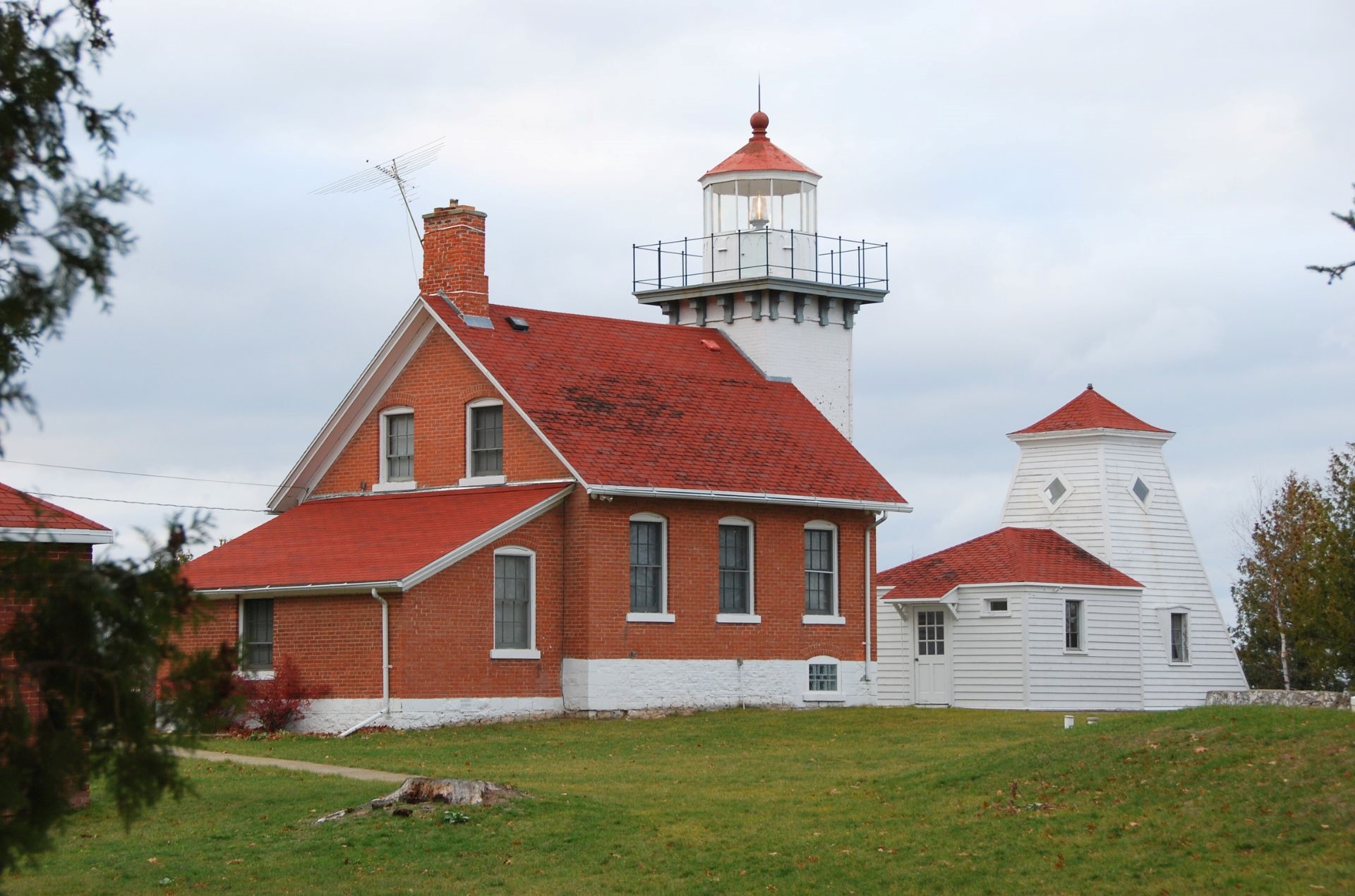
The first lighthouse on the way up the peninsula is Sherwood Point Lighthouse, though it was not the first lighthouse built in the area. Established in 1883, this lighthouse was built to light the mouth of the Sturgeon Bay shipping canal that would reduce the shipping route into Green Bay. The Sturgeon Bay and Lake Michigan Ship Canal and Harbor Company purchased the lot for $125, and Congress allotted $12,000 for the construction of the lighthouse. Today, the project would’ve cost just under $400,000.
The lighthouse’s unique red bricks came from Detroit, in contrast to the usual cream-colored bricks from Milwaukee that other lighthouses in the area had been built with. Sherwood Point Lighthouse was lovingly maintained by its many keepers over the years, and it experienced unique updates in the 1930s such as the installation of running water and electricity and even a radio broadcasting station. It was the last manned lighthouse on the Great Lakes before becoming automated in 1983, a full one hundred years after its construction.
While the lighthouse is closed to the public, you can see it by boat or visit the grounds during the Door County Maritime Museum’s Annual Lighthouse Walk. It’s also open to active U.S. military members on a rental basis as a place for rest and relaxation!
Sturgeon Bay Ship Canal North Pierhead Light

Perhaps one of the most iconic lighthouses in Door County, this cherry-red lighthouse is located at the U.S. Coast Guard station on the Lake Michigan end of the Sturgeon Bay ship canal. This light guides ships into the eastern entrance of the ship canal so they can avoid the narrow passage around the peninsula commonly known as “Death’s Door.”
Since its construction, the lighthouse has assisted with ships entering the canal via its bright light and fog signal, later changed to an air diaphone and supplemented with a radio beacon to aid mariners with limited visibility. The structures at the Sturgeon Bay Ship Canal Light Station are immaculately maintained by the U.S. Coast Guardsmen to this day, though the North Pierhead Light itself is now privately owned. In 2010, a Notice of Availability stated that the lighthouse was “in excess to the needs of the United States Coast Guard,” and it was opened to auction. In 2014, it was sold to an individual for just under $50,000 and is now private property, though the lower level breakwall is open to the public.
Sturgeon Bay Ship Canal Light
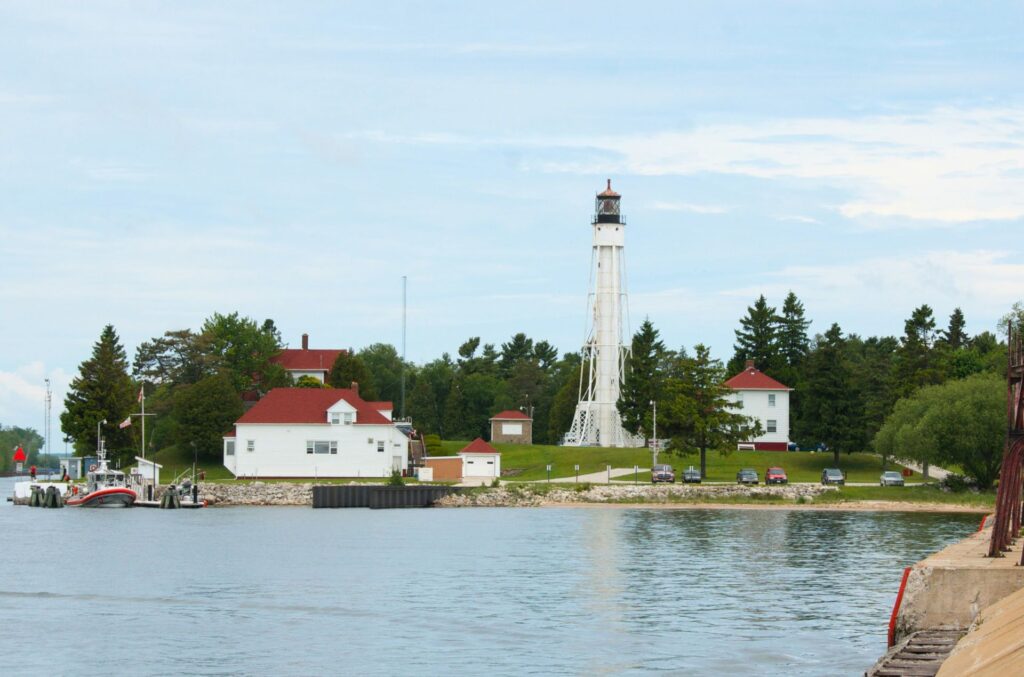
Close by to the North Pierhead Light is its sister lighthouse, the Sturgeon Bay Ship Canal Light. As traffic into the canal increased, complaints rose that the North Pierhead Light was inadequate, as it was only equipped to be a harbor light, not a coastal light. Thus, in 1895, Congress approved funds for the second lighthouse located on the shore.
The lighthouse’s construction was complete just three years later, but the keeper quickly noticed some serious design issues. The tall tower was supported by steel buttresses, but these weren’t enough to keep the tower from violently shaking in the wind. In 1903, the vibration problem was finally resolved with a steel framework that supports the tower to this day. The lighthouse was initially painted reddish-brown, but it blended so well with the surrounding nature that it was later painted white to stand out a bit more for visibility.
The United States Coast Guard took over the Sturgeon Bay Ship Canal Light in 1939 and is still stationed there today, where it maintains the integrity and history of the lighthouse.
Old Baileys Harbor Lighthouse (Bird Cage)
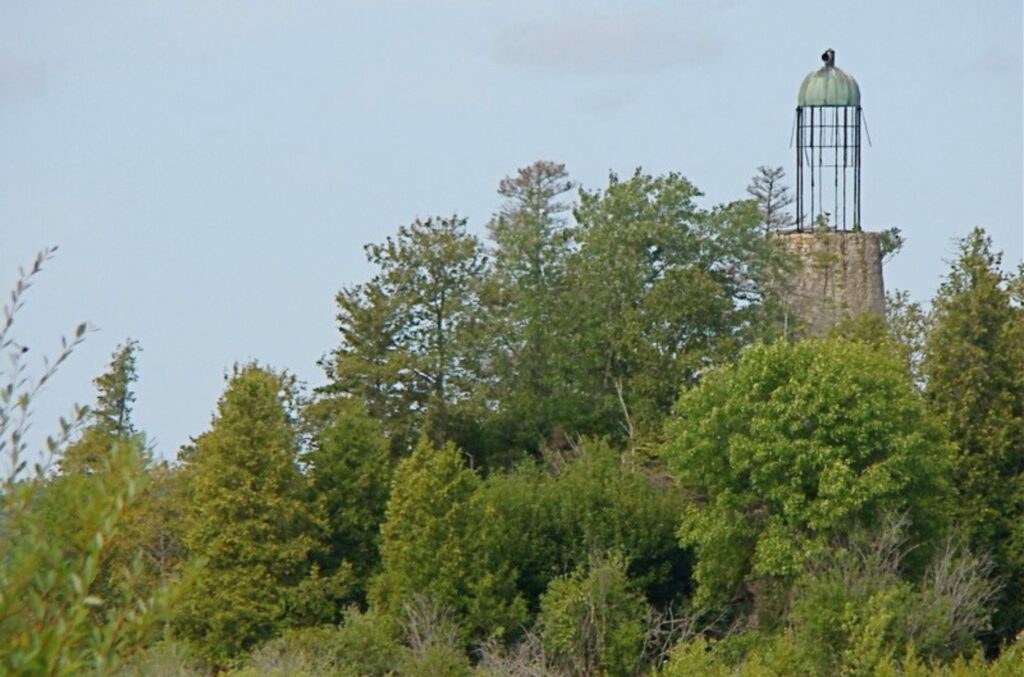
Located on a small island near Baileys Harbor, this old lighthouse, known as the “Bird Cage,” wasn’t open for very long, however its existence was the inspiration for the Range Lights and Cana Island Lighthouse. What makes this lighthouse so unique comes from its name, the Bird Cage, since it’s only one of four lighthouses in the United States with its cage-like lantern.
The island where Old Baileys Harbor Lighthouse sits is called, quite aptly, Lighthouse Island. It was purchased in 1851 for simply $100 ($4,000 today), and construction began in 1852. Only thirteen years after its first opening, the lighthouse was deemed deteriorated and needed to be rebuilt. It was estimated to cost nearly three times as much to renovate the lighthouse as it was to first build it, and renovations were quickly reconsidered. Old Baileys Harbor Lighthouse marked the entrance to Baileys Harbor, but it didn’t provide adequate guidance for ships looking to anchor, as it was surrounded by shallow reefs that sunk many vessels. Thus, the Range Lights and Cana Island Lighthouse were proposed instead, a much more affordable option that would be more useful for mariners.
Old Baileys Harbor Lighthouse’s light was extinguished in December of 1869, but the structure is still standing today. Now, it’s privately owned as a summer cottage, but you can still see it from the water.
Baileys Harbor Range Lights

The Baileys Harbor Range Lights replaced the “Bird Cage” Lighthouse once it was out of commission. Construction was complete in late 1869, and the lighthouse was officially lit and in operation in early 1870.
In 1934, the land surrounding the Range Lights was granted to the Door County Park Commission to use as a park. Initially, some commissioners wanted to turn the land into a trailer park, but quick opposition from those who wanted to preserve the area’s unique nature and environment created The Ridges Sanctuary. In 1972, the sanctuary was granted a 99-year lease for the lights and surrounding acreage. The Ridges Sanctuary then went on to raise $70,000 in the 1990s to rehabilitate the structures! Today, when you tour the park, you can walk right up to the Range Lights, which still provide navigational aid to this day.
Cana Island Lighthouse
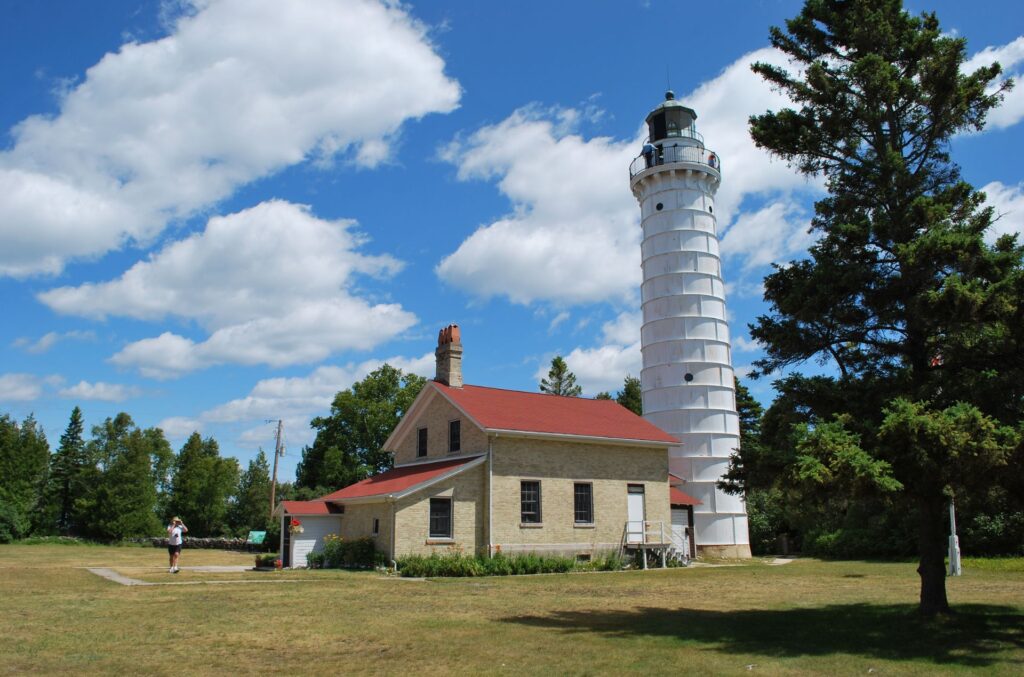
Cana Island Lighthouse is one of the most visited, photographed, and popular lighthouses in Door County! Part of what makes it so accessible to visit is its 300-foot stone pathway over the water from Baileys Harbor to Cana Island, which can be walked on foot or ridden by tractor. Sometimes the pathway is submerged, however, due to Lake Michigan’s fluctuating water levels.
Like the Range Lights, Cana Island Lighthouse was quickly constructed after Old Baileys Harbor Lighthouse’s retirement, and it was in operation in early 1870. The station juts out into Lake Michigan, exposing it to the harsh elements and some of the lake’s worst and most furious storms. One keeper resigned from the lighthouse saying that Cana Island was “one of the most inhospitable and undesirable places” to live.
Cana Island is also home to an infamous shipwreck, though through no fault of its own. On October 3, 1919, a fire broke out on the Frank O’Connor, a cargo ship traveling from Buffalo, New York to Milwaukee, Wisconsin. The fire ate through the ship’s steering, leaving it adrift just a few miles away from Cana Island. The keeper rowed out to assist the sailors in their lifeboats to shore, but the ship sunk. Now, it’s a popular diving spot for visitors!
In 1970, control of the lighthouse was granted to the Door County Maritime Museum, who faithfully maintained the structure and eventually opened it as a museum. Today, you can cross the stone walkway and climb the lighthouse’s tower to see the magnificent views of Lake Michigan!
Eagle Bluff Lighthouse

Eagle Bluff Lighthouse is located in Peninsula State Park, and its construction began in 1868 with the cream-colored Milwaukee brick that most of the lighthouses in the area were built with. Just six months after construction began, the light was lit inside the lantern to provide navigational aid through the Strawberry Channel, the strait of water between the Strawberry Islands and the Door Peninsula.
It wasn’t until the 1930s that the Wisconsin State Conservation Commission was granted the acreage around Eagle Bluff Lighthouse to conjoin it to Peninsula State Park. In 1961, the Door County Historical Society began restoration efforts for the lighthouse, opening it to the public in 1963. Now you can access it in the state park via biking or hiking trails, and it’s open for tours!
Chambers Island Lighthouse
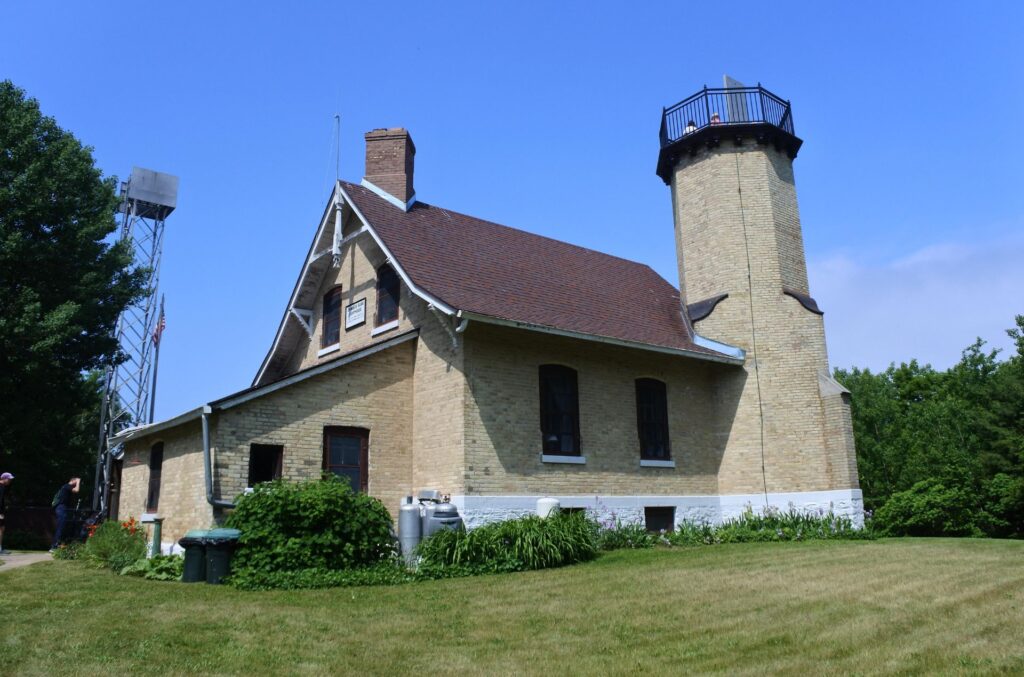
Chambers Island Lighthouse was constructed the same year as Eagle Bluff Lighthouse, built on the largest island in Green Bay. Both lighthouses were built with the same Milwaukee cream bricks, but the major difference between them is the shape of their towers. Like Eagle Bluff Lighthouse, the lantern was lit almost immediately after construction began, just four months later.
Despite the surrounding Strawberry Islands, Chambers Island was known for its large quantity of—you guessed it—strawberries. The first keeper of the lighthouse, Lewis S. Williams, cultivated a large strawberry patch nearby that was admired by visitors during the summer. He would greet them with treats made of strawberries and give them tours of his patch, which was said to have been simply carpeted with red berries!
In 1976, the light station and surrounding land was granted to the Town of Gibraltar for park purposes. Today, the lighthouse itself is closed to the public, but the grounds are available to be walked.
Plum Island Lighthouse
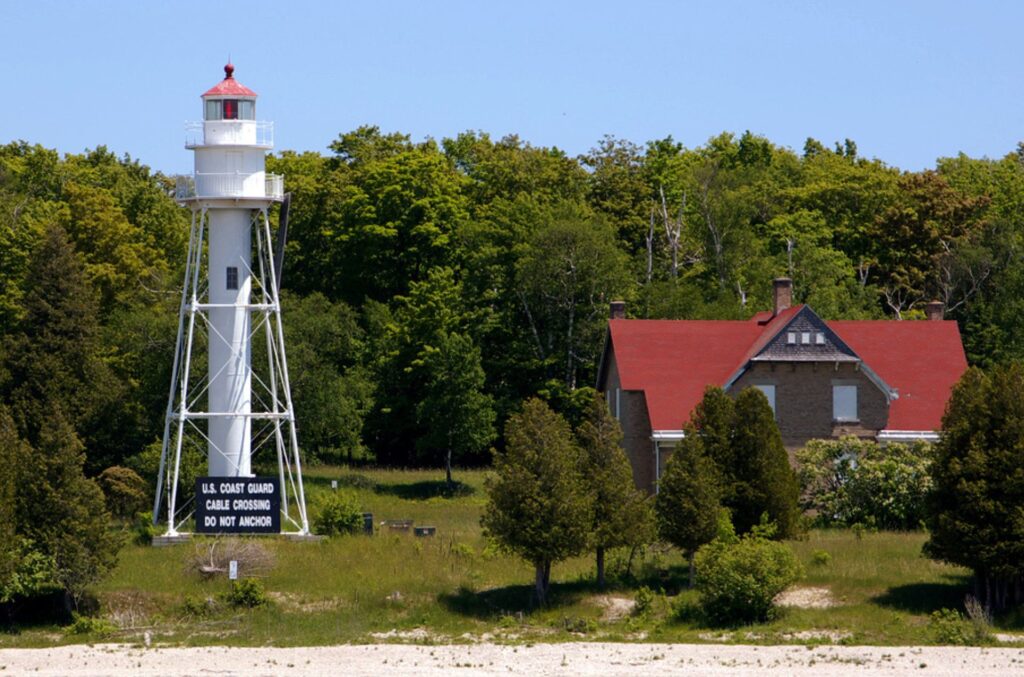
Plum Island Lighthouse was the first lighthouse to grant navigational aid through Death’s Door, the passage between Washington Island and the Door Peninsula. The construction was completed in 1849, but less than ten years later, it was realized that the lighthouse was too far inland to be useful for mariners. Thus, in 1858, the Pilot Island Lighthouse was built to replace it, and Plum Island Lighthouse was abandoned.
However, that was not the end for Plum Island. Despite the additional lighthouse on Pilot Island, mariners still had difficulty deciphering the entrance to the passage, so it was suggested that range lights be built on Plum Island to indicate the proper bearing. The Lighthouse Board agreed, and in 1896, construction began on the Plum Island Range Lights, which were fully operational by 1897.
After World War II, the Coast Guard took over the light stations, automating the lights. The lighthouse was used as a life saving station for the Coast Guard for a while until they moved their operations to Washington Island in 1991, once again leaving Plum Island uninhabited.
In 2007, the Green Bay National Wildlife Refuge took control over the island, and several organizations are working to restore the historical significance of the lighthouse, now on the National Register of Historical Places.
Pilot Island Lighthouse
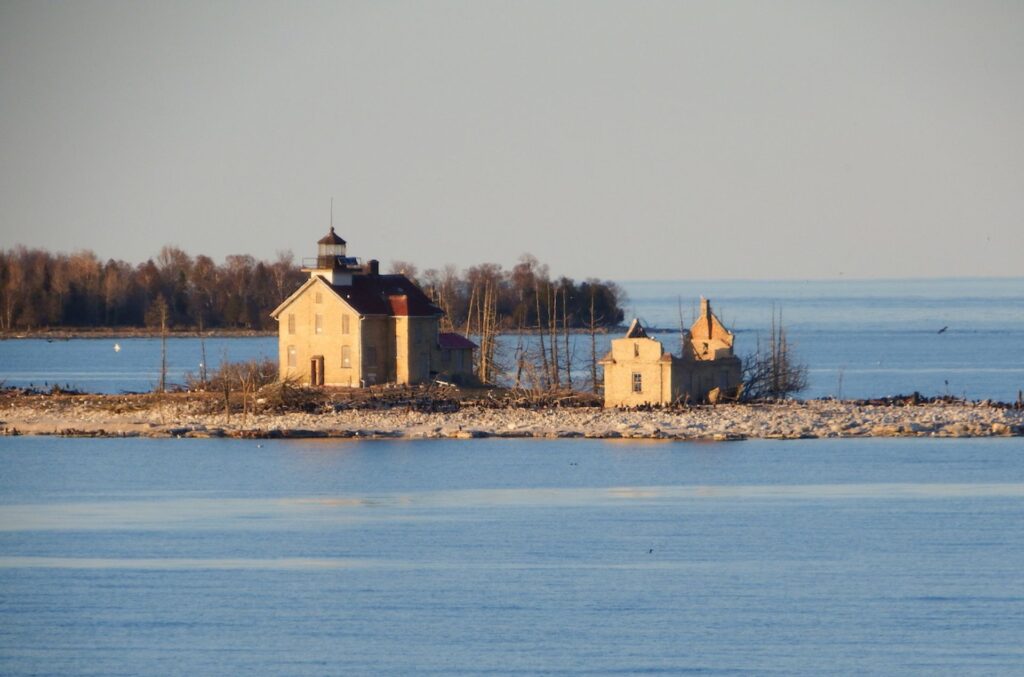
Since Plum Island Lighthouse was deemed too far inland to properly grant navigational passage through Death’s Door, Pilot Island Lighthouse was constructed to replace it. Pilot Island is only a couple miles away from Plum Island, and it’s on the southernmost end of Death’s Door.
Pilot Island Lighthouse was home to several keepers and their escapades, with many fascinating stories of heroic keepers rescuing stranded sailors from thin ice or capsized vessels. The lighthouse was manned until 1962, when the Coast Guard installed an automatic light. Today, the remaining structures on the island have fallen into disrepair, though several organizations are at work attempting to preserve and restore the historic buildings.
Pottawatomie Lighthouse
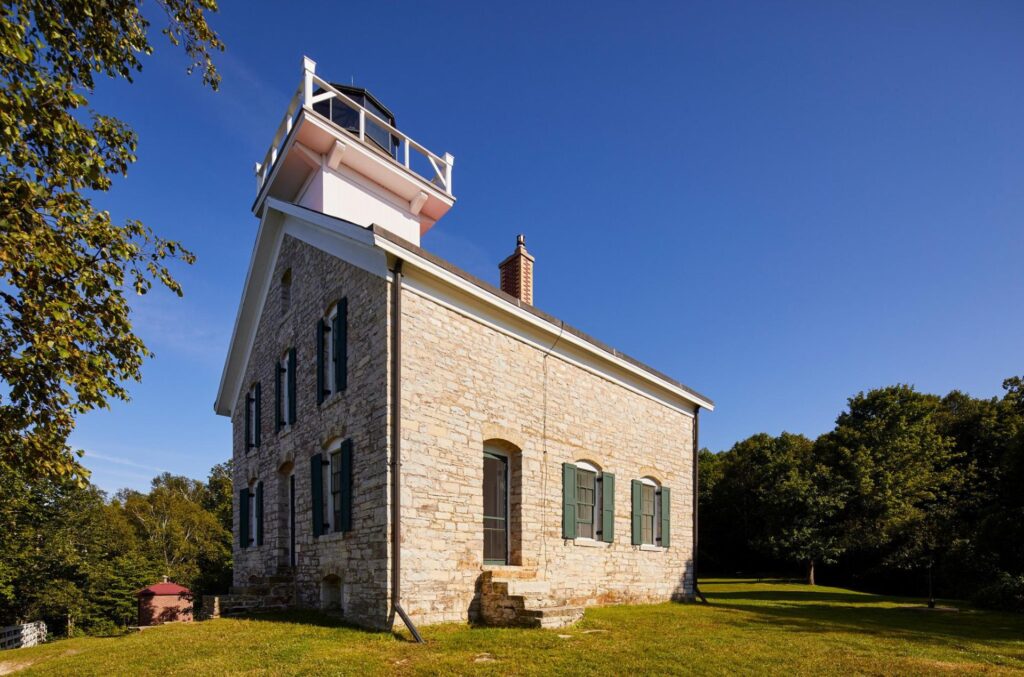
Unlike most other lighthouses in Door County, Pottawatomie Lighthouse was not named after its location on Rock Island, but rather after the Native Americans who once inhabited the land. This lighthouse was the first to be built on Lake Michigan in 1837—over ten years before Wisconsin even became a state!
The lighthouse and its structures were poorly constructed initially and quickly deteriorated, leading to renovations in 1858. Pottawatomie Lighthouse was manned until 1946, when it was replaced with automatic lights. In 1994, Friends of Rock Island State Park began to restore the lighthouse, and it was opened as a museum in 2004.
Thank you to Lighthouse Friends for providing so much information about Door County’s historical lighthouses!


